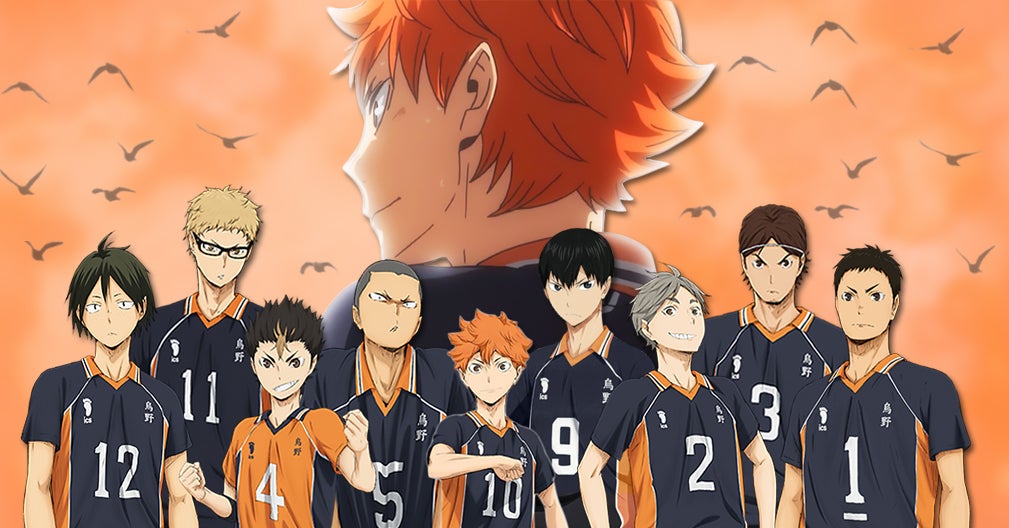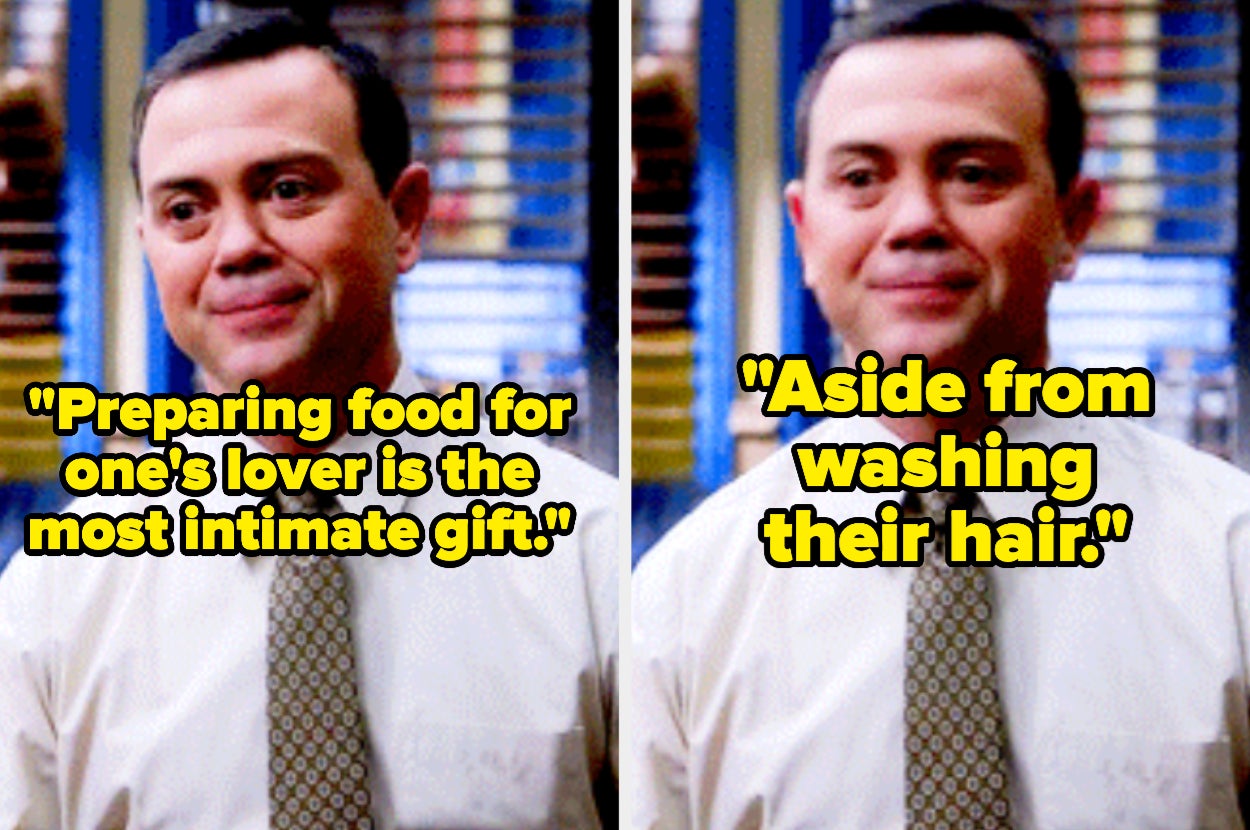[ad_1]
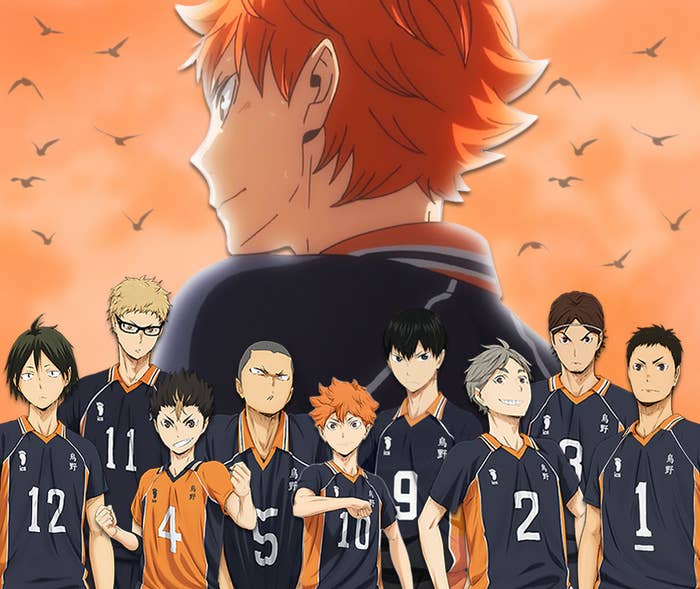
Production I.G / Getty Images / BuzzFeed
A DEEP SILENCE hangs over the court until it is pierced by the loud shrill of the umpire’s whistle, signalling to Karasuno that it’s time to serve the ball. With it being the fifth and final set of the Miyagi Prefecture Qualifier finals, this is the point that could decide whether Shiratorizawa Academy, otherwise known as the undefeated champions, or Karasuno High School, an underdog team who have clawed their way to the top, moves forward to the national volleyball championship. I find myself taking a slow, deep breath to settle my nerves. Whatever happens will be over in a matter of minutes.
There’s block after block, spike after spike, then another attack, but this one dangerously smacks into the face of one of Karasuno’s players. I gasp and put my hand over my mouth, but there’s no time to wonder if he’s okay because the next counterattack is already coming.
Time suddenly slows as Karasuno’s #10 soars into the air like a crow taking flight. He slams the ball and we hear it drop to the ground. My heart beats rapidly as I silently plead, “Please let them score and win.”
Once again, the sound of the umpire’s whistle fills the arena, but this time to confirm that Karasuno has won. The crowd erupts into screams, lifting the tension that I didn’t even realise had gathered so rapidly. I break out into a big smile, which my mum spots while checking up on me. “What are you doing?” she asks. “Oh, I’m just watching some anime.”

PUT SIMPLY, HAIKYUU is a sports anime that follows Hinata Shoyo’s dream to become a renowned volleyball player despite his small stature. Adapted from the best-selling shonen manga series written and illustrated by Haruichi Furudate, the anime has gained a legion of fans from around the world, including the captain of the South Korean National Women’s Volleyball team, Kim Yeon-koung, and Brazilian volleyball player, Alan Souza.
But to fans, this anime is more than just the sports, the volleyball and the flashy rallies — it’s helped us escape the crushing anxiety of living in a world filled with countless problems and given us a reason to smile, to laugh and to forget about the stress of the week. It has gotten us off the couch when nothing else could and allowed us to belong to a community where we can freely express ourselves. But, perhaps most importantly, it’s the overwhelming sense of comfort and belonging which Haikyuu inspires that has given us the strength to navigate through the darkness of 2020.

THE SECRET SAUCE behind the anime’s success and popularity lies in its foundation. Being a shonen-style manga, Haikyuu utilises one of the oldest and most popular tropes known to audiences — a great rivalry between two characters who are continually driven to surpass each other through their competitiveness.
This is seen in the very first episode of Haikyuu, which introduces us to Hinata Shoyo and Kageyama Tobio. Hinata fulfils the role of the loveable shonen hero, with his journey beginning when he sees a short volleyball player, nicknamed “the Little Giant”, dominating the competition. Brimming with confidence and a fighting spirit, Hinata makes up his mind then and there to become the next Little Giant to compete on the volleyball courts.
Going up against him is Kageyama Tobio, who is widely regarded as a prodigy due to his impeccable game sense and pinpoint accuracy in setting the ball exactly where it needs to be to score. But Kageyama’s downfall is his self-centred attitude, with his constant complaining and disregard for his junior high teammates earning him the unfavourable nickname “King of the Court”.
Although Hinata and Kageyama begin on opposite sides of the court, their rivalry takes on a whole new meaning when they meet again at Karasuno High School — but this time as teammates. Forced to see past their differences, Hinata and Kageyama both come to the realisation that they share a strong desire to stay on the volleyball court for as long as possible. But, for them to do this, they need to work together — not as individuals, but as a team.

Production I.G
This proves tricky at first. Having only played one official match, Hinata lacks the necessary technical skills to be a well-rounded volleyball player. But, he more than makes up for this with his speed, stamina and athleticism, which are all traits Kageyama is able to weaponize effectively with his setting abilities. This teamwork results in the formation of their “god-like freak quick”, where Kageyama shoots the ball directly into Hinata’s blindly swinging hand.
Because of the pinpoint accuracy involved in the toss, this leaves no room for error. If the toss from Kageyama is too high, too low or off by just a bit, Hinata will miss it. That’s what makes this attack so incredible — it relies on total trust between both the setter and spiker. Kageyama even makes a point of this when they first establish their “freak quick”, saying “Sure, but who trusts anyone 100 percent?” To this, Hinata replies, “Well, I have no choice but to trust you now.”
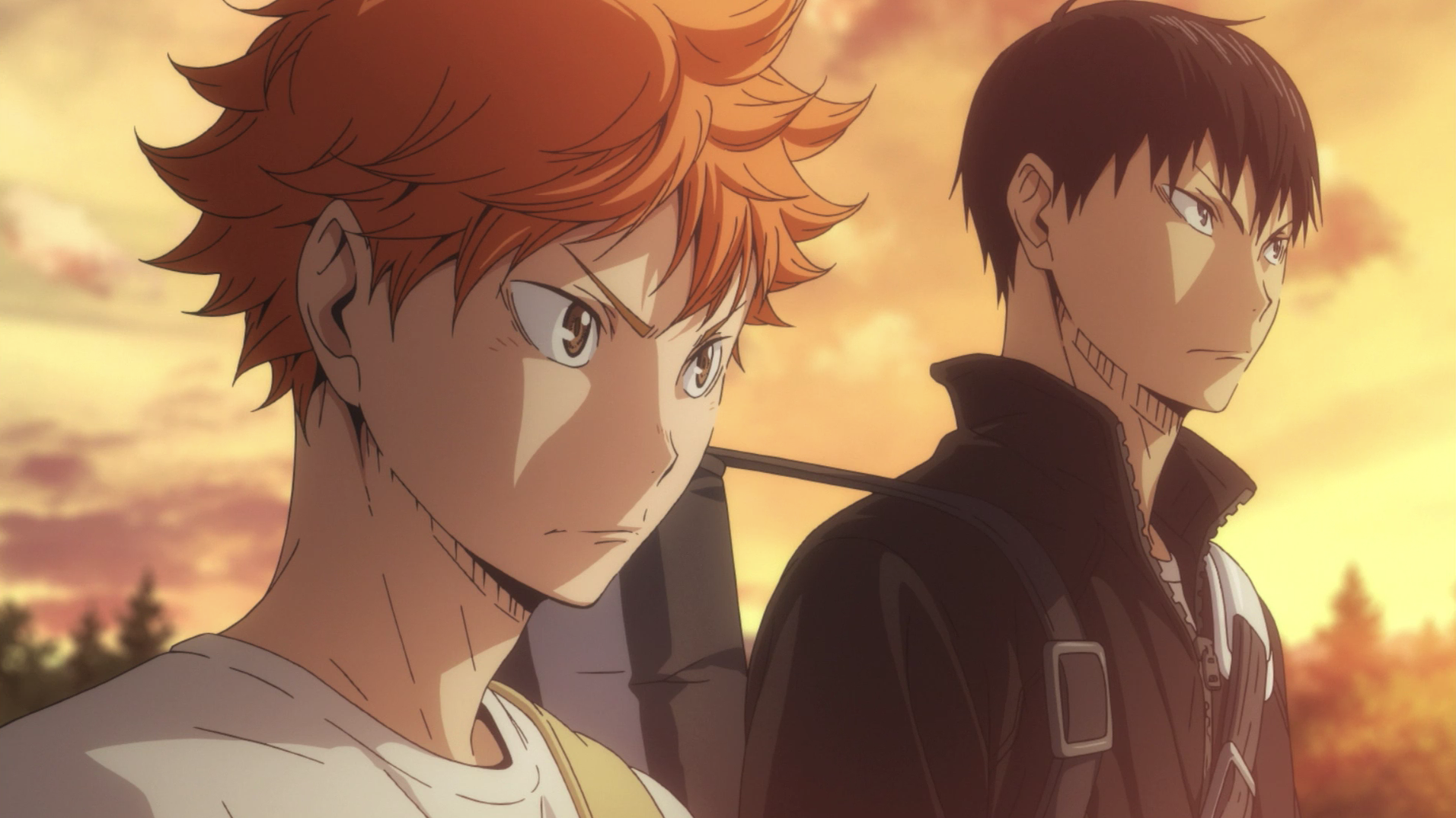
Production I.G

“A tall, tall wall looms in front of me. What’s the view on the other side? What does it look like? The view from the top…it’s a view I could never see on my own. But if I’m not doing it alone…I just might be able to see it.”
ALMOST EVERY SEASON of Haikyuu begins the same way, with Hinata reflecting on what he calls the view from the summit. Essentially, the tall wall represents the blockers on the other side of the volleyball net, but also Hinata’s physical limitations and the obstacles he has to face to overcome them.
By working with Kageyama, Hinata is finally able to rise up and see the view from above — but that’s not enough. The drive to be better and to become Karasuno’s ace, like the Little Giant before him, pushes Hinata to hone his skills over the course of the series, allowing him to evolve into someone who takes control and leads a spiker’s attack rather than relying on the setter.
This is pushed one step further in Season 4, where we witness a shift in Hinata’s personality. After being forced to become a ball boy at a training camp he wasn’t invited to, Hinata takes this opportunity to mature his defensive skills by observing the minute interactions of other players. This culminates in an incredible receive during Karasuno’s match against Inarizaki High, which is monumental for Hinata. It shows that he’s no longer just relying on his instincts, but carefully considering and analysing the game play to figure out his next best move.
Production I.G
As Hinata rapidly improves, so does Kageyama, who rediscovers what it means to be part of a team. This is a central theme in Haikyuu, which often drives home the lesson of understanding that you are not fighting alone to get past your obstacles. On the court, there are six volleyball players on each side — and although they may have their individual skills, the team that works together the best is ultimately stronger. As Sawamura Daichi, captain of Karasuno, points out to Hinata after his quick is blocked for the first time: “You’re alone when you jump, but we’re all behind you.”
Building on this ethos, Kageyama undergoes a transformation of his own. Heeding the advice of Sugawara Kōshi, Karasuno’s third-year setter, he starts communicating with his teammates more, which in turn develops mutual trust and respect between them. That’s not to say that he doesn’t make mistakes, or isn’t the stubborn and arrogant Kageyama fans know and love. But, episode by episode, we see Kageyama shed the “King of the court” nickname that has haunted him since junior high.
To bring it back to the shonen rivalry mentioned earlier, it’s because of Hinata that Kageyama was able to realise his true potential. Through trial and error, they were able to bring out the best in each other’s abilities. As Hinata sums it up: “He was even worse than I could have imagined and we went through a lot, but once we started playing our matches, I felt like we understood each other. It wasn’t that he was the first friend I’d made. He was a partner.”
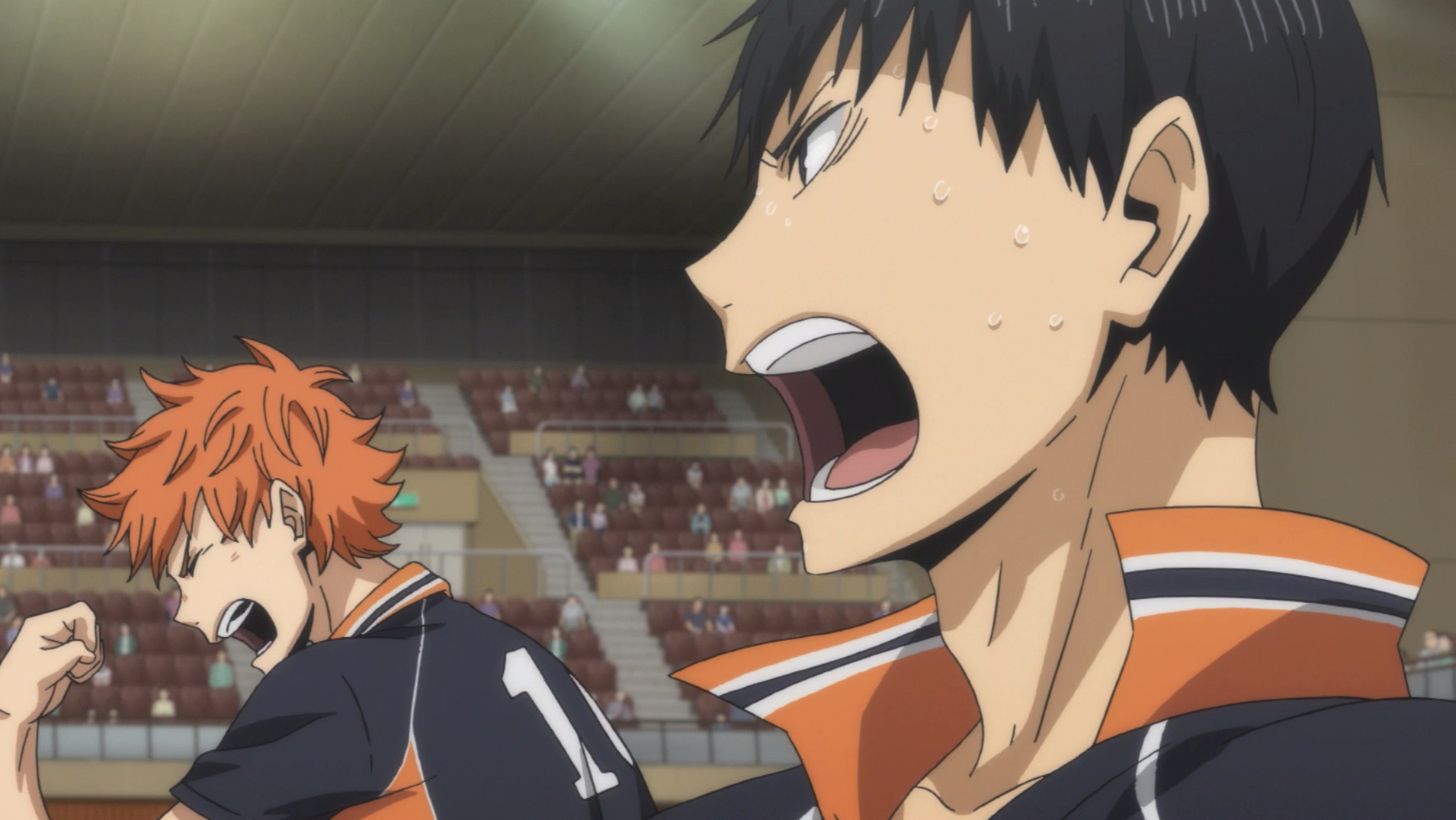
Production I.G

EVEN THOUGH MUCH of the focus is on Hinata and Kageyama, part of the allure of Haikyuu is that everyone in Karasuno is treated like a valuable member of the team. This extends to their character arcs, as the dynamic of Hinata and Kageyama’s rivalry pushes the rest of their teammates to improve and not be left behind.
The most triumphant of these is that of Tsukishima Kei. Despite coming across as arrogant and condescending, Tsukki has low self-esteem and thinks of himself as inferior. But rather than work on his game and improve, Tsukki refrains from putting in effort because he’s terrified that he’ll suffer the same fate as his older brother, who was benched during high school in favour of more talented players. Instead, he uses the excuse of Karaunso’s volleyball team being “just a club” as a defence mechanism to avoid disappointing himself.
Things start to change for Tsukki at a summer training camp in Saitama alongside Nekoma High and Fukurōdani Academy. After seeing the results of Hinata’s hard work, he seeks out advice from his peers, who tell him that even though there’s the risk of failure, “The joy you feel beating the guy in front of you and when you’re able to pull out 120% of your potential is everything.” According to Bokuto Kōtarō, who is Fukurōdani’s ace and captain, Tsukki just needs to have his “moment” — that will be when everything clicks into place and he’ll fall in love with volleyball.
Tsukki gets his long-awaited “moment” during the match against Shiratorizawa Academy, where he finally blocks one of Ushijima Wakatoshi’s spikes. It’s a beautiful, awe-inspiring scene, resulting in Tsukki screaming with joy as he relishes in his hard work and beating a champion player. But, this is just the beginning of Tsukki’s growth — we start to see him chase after difficult balls, make calculated movements and become a pivotal and valued member of the team, as seen in Karasuno’s match against Inarizaki High.
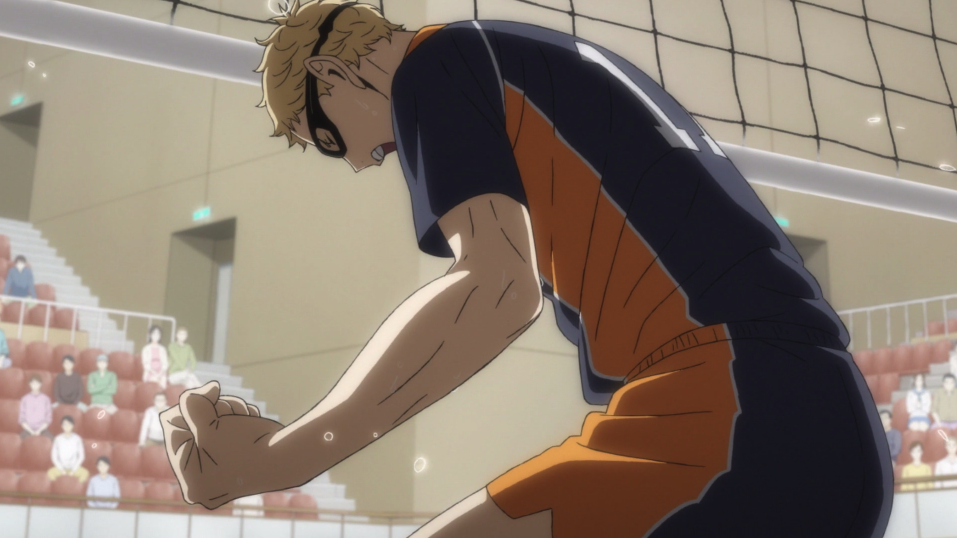
Production I.G
Alongside Tsukishima is his best friend Yamaguchi Tadashi, who is the only first-year that’s not part of Karasuno’s regular lineup. Not wanting to be left behind, he hones in the skill of the jump float serve, which later turns into a powerful weapon for Karasuno. Like other characters in Haikyuu, this is not something that happened overnight for Yamaguchi. He trained hard with his mentor Makoto Shimada, picked himself up from disappointing failures and learned to overcome his constant self-doubt.
Not to be forgotten are the upperclassmen, who nurture their juniors through their constant advice and support. There’s Nishinoya Yu, the quick-thinking libero who is described at the “Guardian Deity of Karasuno”; Tanaka Ryūnosuke, the loud-mouthed wing spiker who never fails to boost the team’s morale and possesses strong mental fortitude; Azumane Asahi; the gentle, but powerful ace who becomes more confident thanks to the help of his teammates; Sugawara Kōshi, the reliable and perceptive third-year setter who acts as a pillar of support for Karasuno and Sawamura Daichi, the formidable captain who gives Karasuno a solid foundation through his receives and leadership. Throughout the series, they see the hunger for success in the first-years and are inspired to work even harder to ensure that the senpais aren’t surpassed without a fight.
Together, they make the volleyball matches — and by extension, Haikyuu — worth watching. Episode by episode, you become emotionally invested in their redemption story to restore Karasuno’s reputation and make it to nationals, while falling in love with the quirks, strengths and flaws of each character.
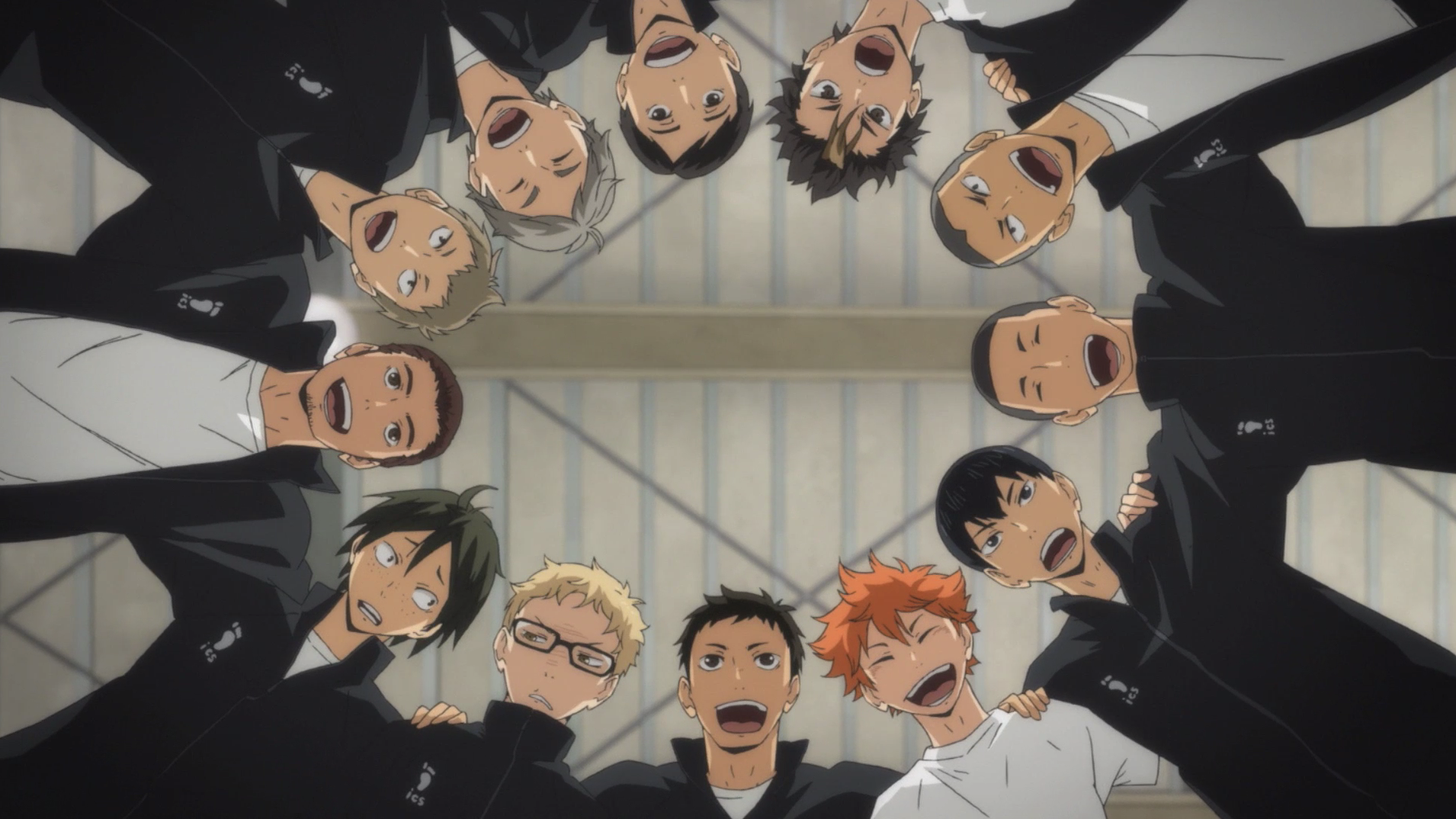
Production I.G
While there’s no better enjoyment than watching Karasuno’s team grow and develop, it’s even more satisfying to see it play out alongside the other high school volleyball teams. Furudate takes great care to breathe life into his entire ensemble of characters, ensuring that we get to know them just as well as our heroes.
Time and time again during the training camp arcs, we see Nekoma captain Kuroo Tetsurō lecture Lev Haiba about his blocking skills while offering advice to Tsukishima, Bokuto showing his strength as Fukurōdani’s ace while teaching new moves to Hinata and Karasuno experimenting with new attacks — which often result in them having to perform the loser’s penalty. All this is done to remind fans of not only the value of mateship and friendly rivalry, but that success can be achieved through repeated failure and gradual improvement.
No matter the team in Haikyuu, they all silently root for their opponents to improve because they know that will only result in them pushing themselves to be the best that they could possibly be.

THE BRILLIANCE OF Haikyuu’s characters shines best when it makes you unsure of who exactly you’re rooting for. The show rarely paints the teams opposing Karasuno as the enemy — they’re just other players, who have their own goals and want to win just as badly as our Crows. That’s why when Karasuno are facing even their most intimidating opponents, like say the powerhouse Aoba Johsai, their sweet victory comes with a slightly bitter aftertaste as you see the losing team’s dreams crushed.
This conflicting viewpoint in Haikyuu heightens the tension of matches, which is further amplified through the striking animation and cinematography. Each frame is dedicated to capturing not only how it feels to watch volleyball, but how it feels to play it. We see the heaviness of the spinning ball impacting on a player’s wrists while they receive, but we also feel the impact it makes on the flesh. Likewise, we see the ball slamming down into the court, but we also feel the whoosh and power of the spike. And, of course, we see Hinata soar into the air to hit the ball, but we also feel the wonder of his team, and everyone around him, watching him fly in order to reach the view from the summit.
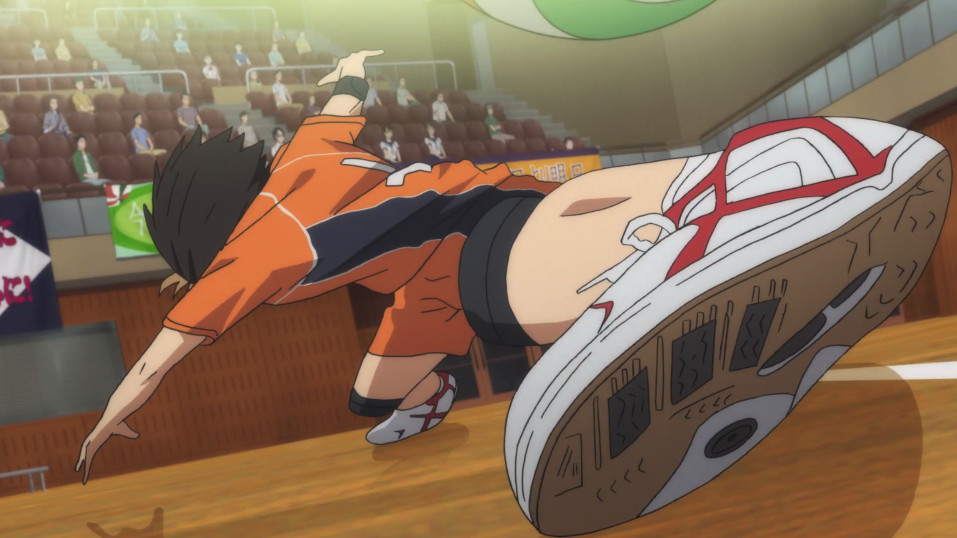
Production I.G
Alongside this, there’s the minute attention to detail that adds yet another layer of realism. Some of it is subtle, like the inclusion of players taking a deep breath before they serve, the reflection of the ball in their eyes or the movement of the muscles in their legs. Others offer a different perspective, such as the POV shots that follow the ball during those intense rallies. Combined with the incredible soundtrack by Yuki Hayashi and Tachibana Asami, which is perfect at amplifying the excitement and teasing out the tension, you’re made to feel as if you’ve been transported straight to the volleyball court and are cheering on Karasuno from the sidelines.
Your heart beats rapidly when the opposing team takes the lead, you shake your head when they gain the upper hand and you get fired up when you hear someone shout “Chance ball!” and “Pick it up!”, because that means there’s an opportunity to turn things around. But most of all, you revel in the joy and happiness of scoring a point, throwing up your hands and curling them into fists, screaming “ALL RIGHT!” alongside your favourite characters.
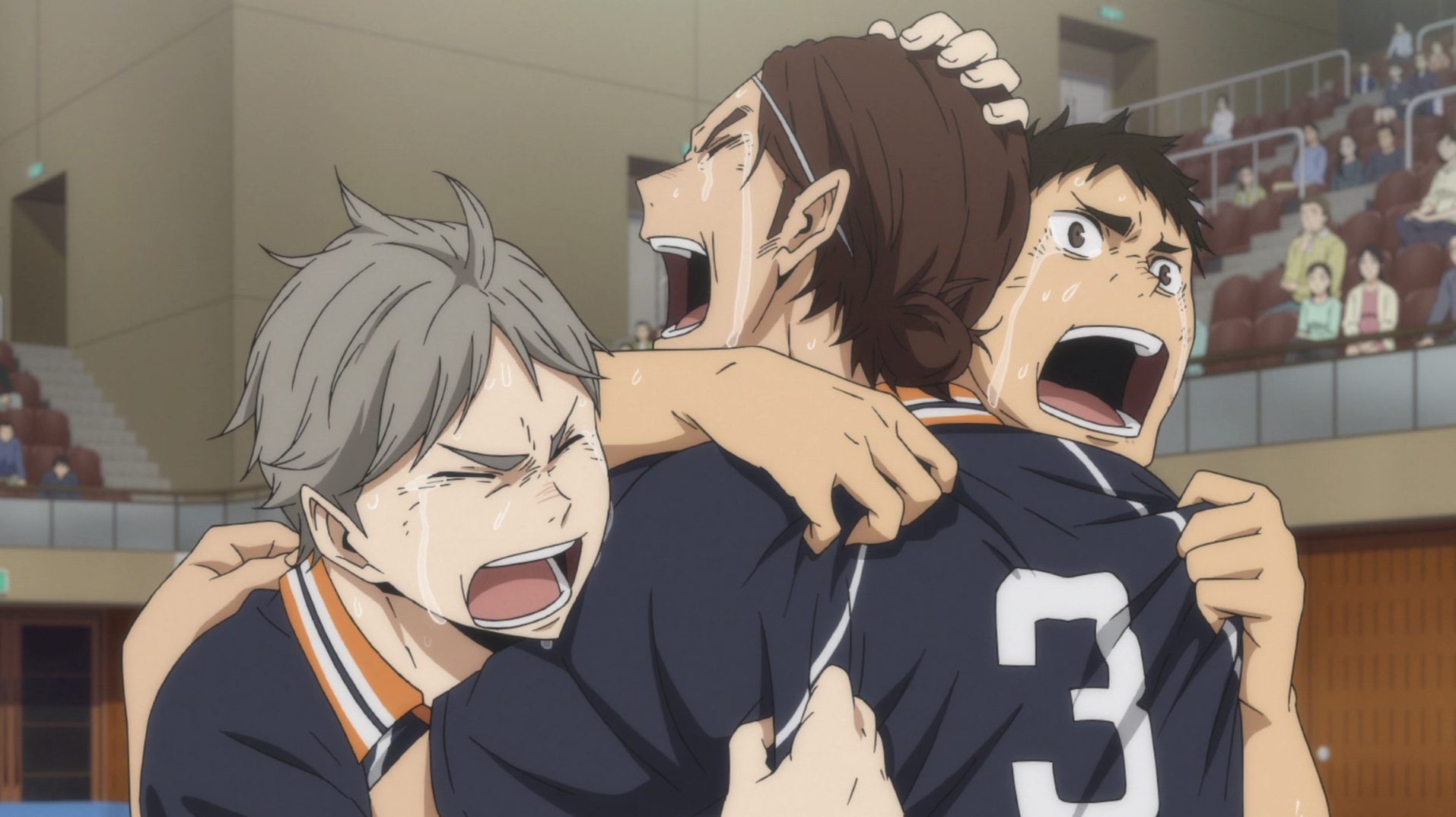
Production I.G
If it’s not already evident, watching Haikyuu is truly an experience like no other. The enthusiasm that Karasuno and the others demonstrate in their fight to win is infectious. No matter the opponent, no matter the struggle, they give it their all to ensure that there are no regrets. They understand that one point could potentially make all the difference and change the momentum of the game. To them, there is no victory without taking risks — and all of that emotion and fighting spirit is imparted on you while watching the brilliance that is Haikyuu.

“Does losing prove that you’re weak? Isn’t losing difficult for all of you? A challenge where, after ending up on your hands and knees, you must see if you can stand up again? If you stay on your hands and knees, that proves you are weak.”
There are many brilliant quotes in Haikyuu, but the above one told by Takeda Ittetsu, the faculty advisor of Karasuno’s volleyball team, after their loss to Aoba Johsai has stuck with me the most.
So far in this piece, I’ve talked a lot about why Haikyuu is a fantastic anime, but I haven’t yet touched on what it means to me. Perhaps there’s a reason for that — I sometimes struggle with sharing my feelings, although I consider myself to be an emotional person. I’m a crier, I get angry, I get frustrated, I laugh a lot (loudly, too!) and I voice my opinion because I am passionate about the things I believe in. But at some point this year, I got tired of doing and being all of those things, instead choosing to retreat into myself and the room that COVID-19 locked me into.
The world of Haikyuu isn’t real, but the emotions that I, and many other fans, feel
when we watch it is.
With work becoming my measure of success and productivity, I found myself in a hole that I kept on digging deeper and deeper into as I took on task after task and project after project. I simultaneously felt like I needed to do more, while feeling like I was already drowning under the strain I had placed myself under.
I was fighting a battle with 2020 — and I was losing, badly. I was mentally exhausted and physically drained, but I still kept on doing the same routine because I refused to stop and have to deal with my life. That’s not to say I didn’t have good moments or supportive friends to help lift me up. But, watching Haikyuu and developing a connection to the characters and the storyline lifted my spirits in a way that nothing else this year did.
Not everyone reading this will understand that. They’ll say, “But it’s just an anime, right? It’s not real.” And you’re right — the world of Haikyuu isn’t real, but the emotions that I, and many other fans, feel when we watch it is. I’ve never smiled harder, laughed as loud, become as emotionally invested or felt more at peace than when I’m watching an episode of my favourite sports anime. And the result? I feel more like “me” than I have in months — and heading into 2021, I’m inspired to finally become the best version of myself that I’ve missed out on being.
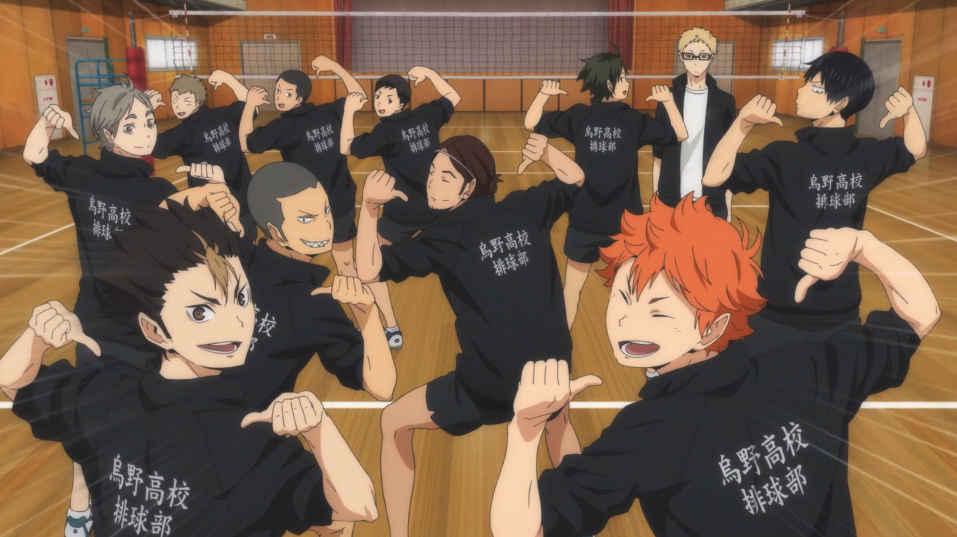
Production I.G
Even though 2020 has been a loss in so many ways, it’s similar to Karasuno sharing a meal together after their defeat to Aoba Johsai. With tears streaming down their face, they eat to not only repair their weary muscles, but to become stronger, little by little, so they can grow and defeat their opponent the next time. And it’s time for me to do the same, so I can get off my hands and knees and stand up strong, once again.
A special thank you to Haikyuu, everyone involved in making it and the fans that I’ve connected with. There’s a lot to work on, but we’ll get there together, as a team.
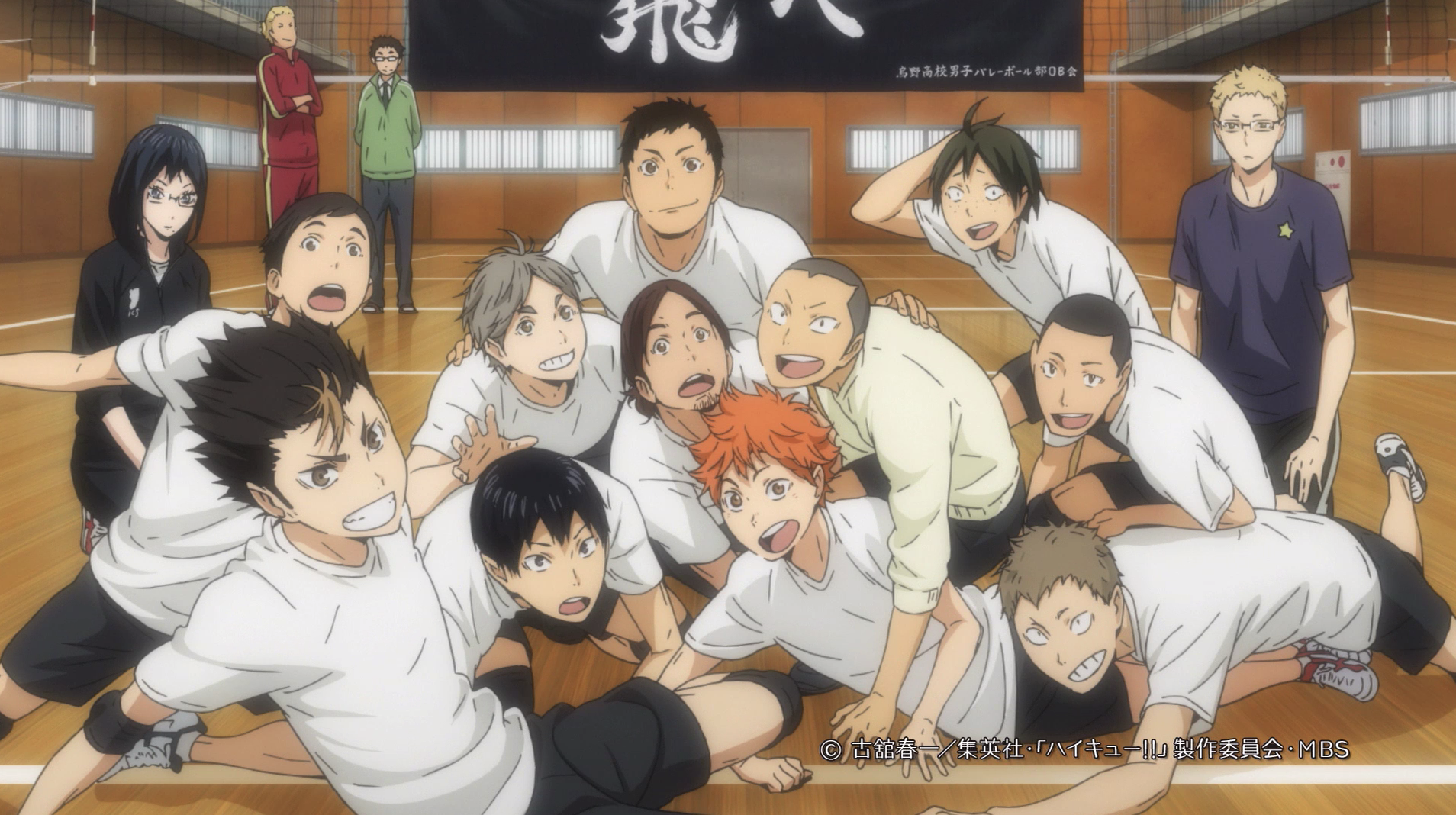
Production I.G
[ad_2]
Source link

